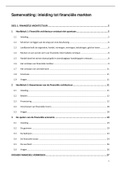Summary
Inleiding tot de financiële markten 1 - Samenvatting
- Course
- Institution
Samenvatting Inleiding tot financiële markten 1. Opleiding: schakelprogramma organisatie en management. Academiejaar - tweede semester. Lector: Marc De Ceuster. Samenvatting van de slides met extra uitleg - toelichting bij grafieken etc.
[Show more]



